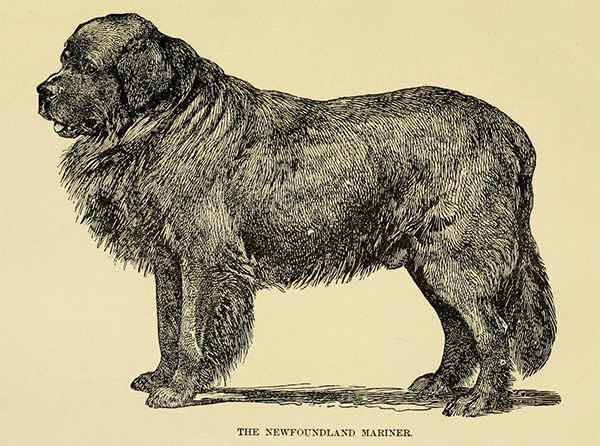[ Mills / The Dog in Health and in Disease ]
Mills (1847 - 1915) was both a medical doctor and veterinarian, and wrote a number of works on canine topics.
This book seems to have been first published in 1892 with a second edition in 1895;, the text below is taken from the 1913 reprinting of the 2nd edition (New York: Appleton).
Newfs are mentioned glancingly in the brief paragraph on Chessis — about whom Mills says "nor are they handsome dogs" — though he doesn't mention the oft-remarked story that Newfs are behind the Chessie, only that Chessies are "intermediate in form between the Newfoundland and Irish water spaniel" (74).
Mills' entry on the Newfoundland is as follows:
Employed for draught purposes on the island from which he derives his name, but else- where chiefly as a companion. Being an animal of won- derful sagacity and nobility of nature, he was long one of the greatest of canine favorites, but at present yields in popularity to the gigantic St. Bernard. His feats in life-saving have done much to make the canine race popular and respected.
The Newfoundland's general appearance is that of a dog of strength and general activity. He should move freely on his legs, with the body swung loosely between them, so that a slight roll in gait should not be objectionable ; but at the same time a weak or hollow back, slackness of loins or cow-hocks, constitute grave faults.
Head. — Broad and massive; top of skull flat; occipital protuberance well developed, but, unlike the St. Bernard and mastiff, he has no decided stop; muzzle short, clean-cut, and rather square in shape, covered with short, fine hair; eyes small, dark-brown, rather deeply set, without haw and somewhat wide apart; ears small, set well back, square, with the skull lying close to head, covered with short hair and without fringe.
Should be sound throughout. A sway-back, slack loin, cow-hocks, and splayed feet are very objectionable, as before stated, and they are not uncommon.
Tail. — Without flag but covered with long hair, usually carried low, and with slight curve; when the animal is excited or in motion, carried higher, but never curled over the back, and should never have a kink (turn to one side) in it.
Color. — Jet black.
Coat. — Flat, dense, coarse in texture, oily, elastic.
Height and Weight. — Average height, twenty-seven inches at shoulder for dogs and twenty-five inches for bitches; average weight, one hundred pounds and eighty- five pounds, respectively. Large size desirable if accompanied by other good points and general symmetry.
Other Varieties of Newfoundland. — The St. John's or Labrador dog is smaller and more retriever-like in form; in fact, it is probable that this breed has entered into the formation of the retriever.
The Landseer Newfoundland should in all respects follow the black dog except in color, which may be any that disqualifies for the black class; but those most in favor are bronze or black and white, beauty in markings to count high. (78 - 80)


